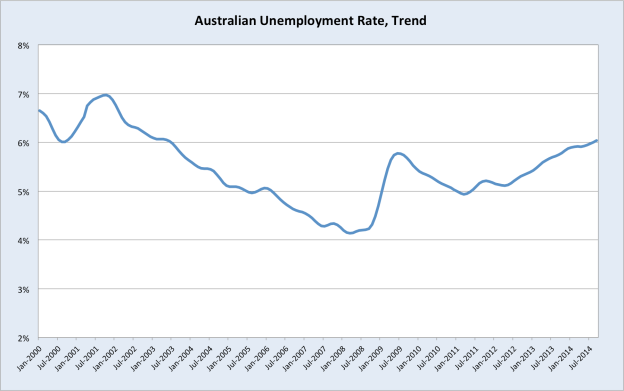Last month’s seasonally-adjusted jobs figure was wonderful, except for the fact that it didn’t pass the laugh test. As I said at the time, I more or less ignore the seasonally-adjusted roulette wheel and focus instead on the trend data, which seem to provide the most reliable reading on the health of the labour market. But the volatile seasonally-adjusted figure still presents a troubling breakdown of respectability at the ABS.
Yesterday they acknowledged as much. The 120k jobs supposedly created in August was an adjusted figure based on seasonal patterns which the ABS believed were present this time of year. Yesterday that figure was revised down to a more-believeable 32.1k, as the ABS has decided that seasonal influences of past years aren’t exerting themselves in 2014.
Here’s the latest reading on the labour market. The revised jobs gain last month has been largely wiped out, with a seasonally-unadjusted 29.7k jobs lost. The unemployment rate ticked up to 6.1%. 5.6k jobs were created on a trend basis and the unemployment rate held steady at 6%.
The ABS isn’t exactly sure why previously observed seasonality is not showing up this year, however the following possibilities were offered:
It could have resulted from one or more factors including changes in ‘real world’ labour market behaviour, changes in the timing and content of the supplementary survey program (run in conjunction with the Labour Force Survey), the introduction of web-forms, the introduction of the new labour force questionnaire, or refinements to collection procedures.
Given the sudden shift away from the usual seasonal patterns, the ABS has determined that the usual seasonal adjustment process, based on patterns in previous years, is not appropriate for application for the most recent months’ estimates.
As such, they’ve set the adjustment factors to one for July, August and September, meaning no change has been made to the original data to reflect seasonality. If this sounds as though the ABS is groping about in the dark, then you’re on the same page as me. Only about .32% of the labour force is captured in each survey, which is fine, that’s how statistics works, but it bears remembering that any deficiencies in the collection and organization of the sample, either through incompetence or inadequate resources, can easily screw around with the output.
It certainly appears as though the problems at the ABS stem partly from a lack of resources. Both the current and the previous government have sought to reduce funding and squeeze greater efficiency out of the ABS. Whether this is the chief cause of the labour force survey woes, I cannot say. However I can say with no uncertainty that one of the proposed solutions to this problem would be bad news for Strayanomics. According to Hockey, a user-pay system for ABS data is “one of the things we’ve been actively looking at and I’ll be taking initiatives to cabinet in the next few weeks.”
The ABS has a budget of a little under $400m. This is less than .1% of the Federal government expenditures. I am quite aware of the pressures on the Federal budget, indeed I have been pointing out for some time that they are in considerably worse shape than many commentators recognize. There are many bones of contention when it comes to the current government’s strategy for reducing the deficit, and these are mostly political questions around which segments of society should be targeted for tax hikes and spending cuts.
Perhaps some would disagree, but I do not consider adequate funding of the ABS to be a debatable political issue. Access to sound economic statistics is paramount to the government’s entire macroeconomic policy mandate. The ability to craft and implement effective macroeconomic management is all the more difficult if you don’t have the clearest picture possible of conditions in the economy and the outcomes of policy choices. So while it’s hard to see the government allowing further funding pressures to hinder the ABS, adopting a user-pay model to access the bureau’s data would be a regrettable solution.
Firms are afforded free access to ABS data and may use it for research purposes to generate revenue. They would be inclined to pay for that data, assuming it is integral to their business. For a blog like Strayanomics, with no suggestion of it generating revenue except in moments of pure jest, I can tell you it is a pain in the ass trying to get data at the best of times. Publicly available statistics are therefore the life-blood of amateur analysis. They offer any interested citizen the means to check for themselves whether the pronouncements of the media or politicians bear any resemblance to reality.
Discouraging such inquiry by charging for basic information about the state of our nation would be a sadly regressive step; a blow to the Open Society.


